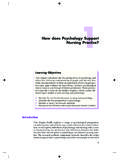Transcription of Service Area Competitor Analysis - Blackwell Publishing
1 CHAPTERS ervice AreaCompetitor Analysis The competition will bite you if you keep running; if you stand still, theywill swallow you. William Knudsen, built and was operating 13 free-standing hearthospitals, began having discussions with local cardiologists. MedCath partnered with cardio-logists, cardiovascular surgeons, and other physi-cians to deliver patient-focused health care to thosewith cardiovascular disease. MedCath enabled physi-cians to be involved in the design and planning of the facility as well as managing its physicians were involved in ownership,enabling them to enhance stagnant targeted states, such as Indiana, that didnot have certificate of need (CON) a defensive ploy, and to avoid the potentialloss of physicians (and through them, their patients),Indianapolis Service area hospitals forged partner-ships with physicians to consolidate or expandA heart-care building boom is occurring in manycities, although the volume for open heart surgeryseems to be declining.
2 Critics believe that over-building may split up heart surgery volume enoughthat many facilities will not meet Leapfrog-recommended volume standards just at a time whenconsumers are becoming much more aware of them(see Perspective 6 1 on the Leapfrog Group). Forexample, in Milwaukee, 13 cardiology programsserve a population of million, whereas Clevelandhas five open-heart centers for a metropolitan statistical area (MSA) of million and Rochesterhas two programs for a population of the Indianapolis Service area , cardiac capacityincreased 15 20 percent in the past three years. The reason? MedCath, the for-profit corporation 3 Introductory IncidentCompetition Revs Up in the Indianapolis Service AreaSMOC03 7/22/05 1:09 PM Page surgery programs.
3 Each of the four hospitalsystems Clarian Health Partners, CommunityHospitals of Indianapolis, St. Vincent Hospitals,and Wishard Health services built free-standingheart hospitals and two of them Clarian and St. Vincent were built as joint ventures for Marion County (which includesIndianapolis) is million. The IndianapolisMSA includes nine counties with a population of more than million. The MSA has more than3,600 physicians ( per 1,000 population) and15,800 registered nurses. Although the MSA has staffed hospital beds per 1,000 population, thecity of Indianapolis has staffed beds per 1,000 penetration is low in the city (21 percentand declining); most of the 22 major employers(including Eli Lilly, Anthem, Inc.)
4 , and Conseco,Inc. on the Fortune 500 list) offer PPOs. About 12 percent of the population is without healthinsurance (13 percent in the county). In both the cityand the county 11 percent of the population is over65 years of age (compared with an average of 15 per-cent for the United States).Indianapolis had been a city where health care wasdescribed as genteel competition but that is nolonger the case. Competition among the hospitalshas intensified as several of the systems have builtnew hospitals or significantly renovated olderfacilities in what has traditionally been others geo-graphic market areas. Some of the construction isdesigned to move services of flagship hospitals tomore lucrative, faster growing areas (outside the citylimits of Indianapolis).
5 In addition, St. Vincent sHospital opened a children s hospital to competewith Clarian s Riley Children s Hospital (affiliatedwith Indiana University and historically the only children s hospital in the region). Orthopedicsgroups were announcing plans to open orthopedichospitals and oncologists were in discussions witha for-profit national company, spurring hospitals to build additional outpatient cancer addition, there has been friction among thephysicians at Indiana University and MethodistHospital (merged in 1997 to become Clarian HealthPartners) such that many physicians affiliated withMethodist have left to go to competing hospitals,undermining Clarian s dominant market and medical care in the Indianapolis ser-vice area is very competitive.
6 With populationgrowth, will demand for cardiac services increase20 percent over the next few years to utilize the newfacilities? Will each of the heart centers performsufficient numbers of surgeries to remain com-petitive? Which of the systems will be survivors in such a competitive market?Source: Aaron Katz, Robert E. Hurley, Kelly Devers, LeslieJackson Conwell, Bradley C. Strunk, Andrea Staiti, J. LeeHargraves, and Robert A. Bereson, Competition Revs Up theIndianapolis Health Care Market, Community Report No. 1:Indianapolis (Washington, DC: Center for Studying HealthSystem Change, Winter 2003) and Michelle Rogers, Cardio-vascular services : Heart Race, HealthLeaders(January 28,2004) at 7/22/05 1:09 PM Page 3.
7 Service area Competitor ANALYSISL earning ObjectivesAfter completing this chapter the student should be able the importance of Service area Competitor Analysis as well as its the relationship between general and health care environmental issueidentification and Analysis and Service area Competitor and analyze the Service area for a health care organization or specific health a Service area structure Analysis for a health care strategic groups and be able to map competitors strategies alongimportant Service and market the elements of Service area Competitor Analysis and assess likelycompetitor general environmental and health care industry issues with Service area andcompetitor issues and synthesize specific strategy several questions to initiate strategic thinking concerning the Service area andcompetitors as a part of managing the strategic Focus in External Environmental AnalysisEnvironmental Analysis involves strategic thinking and strategic planning, focusing on increasingly more specific issues.
8 Chapter 2, Understanding andAnalyzing the General Environment and the Health Care Environment, providedthe fundamental approach and strategic thinking frameworks for scanning, monitoring, forecasting, and assessing trends and issues in the , once the general and industry trends and issues in the external environ-ment have been identified and assessed, a more specific Analysis is required. As shown in Exhibit 2 1, Service area Competitor Analysis is the third part of acomprehensive environmental Analysis . Service area Competitor Analysis attempts tofurther define and understand an organization s environment through identify-ing specific Service area / Service category issues, identifying its competitors,determining the strengths and weaknesses of these rivals, and anticipating theirstrategic moves.
9 It involves collecting data concerning the Service area and rivalsto analyze and interpret the data for strategic decision Service AreaThe Service areais considered to be the geographic area surrounding the health careprovider from which it pulls the majority of its customers/patients. It is usuallySMOC03 7/22/05 1:09 PM Page FOCUS IN EXTERNAL ENVIRONMENTAL by fairly well-defined geographic borders. Beyond these borders, servicesmay be difficult to render because of distance, cost, time, and so on. Therefore, ahealth care organization must not only define its Service area but must also analyzein detail all relevant and important aspects of the Service area , including economic,demographic, psychographic (lifestyle), and disease pattern Service area is defined by customers preferences and the health care pro-viders that are available.
10 Certainly, the consumer has become empowered by theamount of information available concerning disease conditions and providers (see Perspective 3 1). Exhibit 3 1 shows the determinants of a Service areaThe empowered patient has become a significant presence in the healthcare environment and a challenge for health care organizations. With con-fidence gained from Internet access and media exposure, the patient oftenhas an opinion and may not appreciate the paternalistic style of healthcare delivery, no matter how well-intentioned. Informed consumers expectto be participating partners in their own health care and when their families need is an upside to this challenge.










